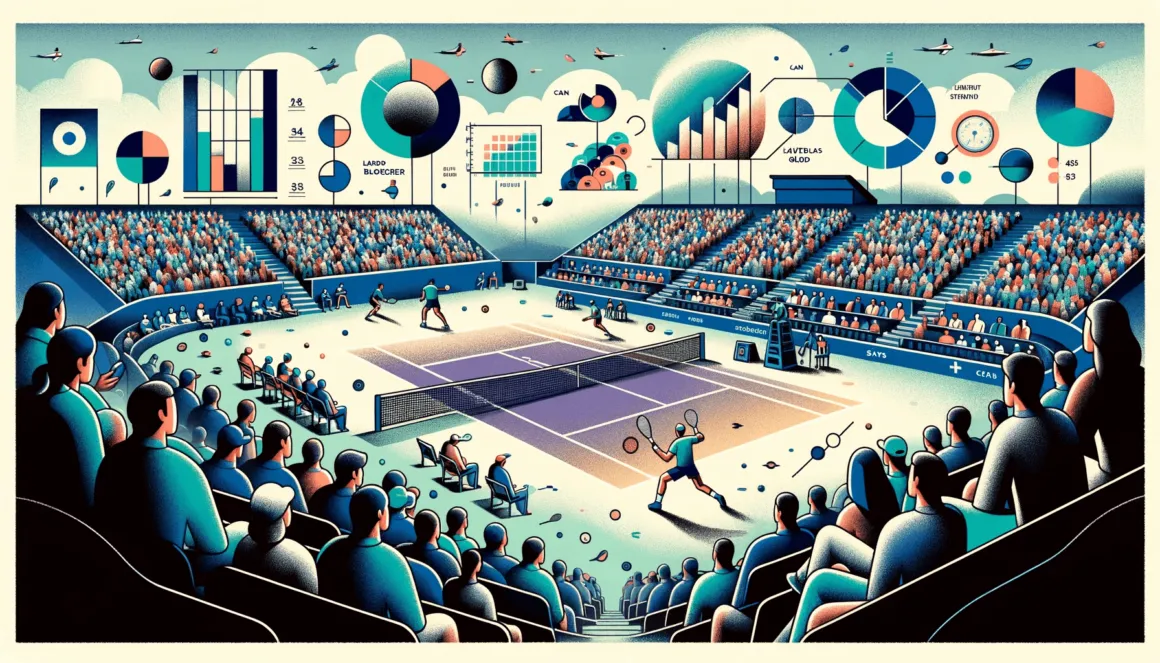Tennis is a sport that has captured the hearts and minds of people all over the world. With its rich history, thrilling matches, and charismatic players, tennis has become one of the most watched sports in the world. As the popularity of tennis continues to grow, so does the interest in its viewership statistics. In this article, we will explore the impact of tennis viewership statistics on the sport, from its evolution to its current state and future prospects.

Evolution of Tennis Viewership Statistics
The first recorded tennis match took place in 1874 between Harry Gem and Augurio Perera, with only a handful of spectators present. However, as the sport gained popularity, so did its viewership. The early years of tennis had limited technology, and official records of viewership were not available. It wasn’t until the advent of television that tennis viewership statistics began to be accurately recorded.
The Rise of Television Coverage
Television coverage of tennis was first introduced in the 1920s, but it was not until the 1960s that it became a regular feature. With the introduction of color TV in the 1970s, tennis viewership saw a significant increase as fans could now watch their favorite players in vivid color. This led to a surge in the popularity of the sport, and tennis began to attract big-name sponsors and advertisers, further boosting its viewership.
The Influence of Grand Slam Tournaments
Grand Slam tournaments, such as the Australian Open, French Open, Wimbledon, and US Open, have always been the pinnacle of tennis and continue to attract millions of viewers each year. These tournaments are broadcasted globally, giving fans around the world access to live matches and highlights. As a result, the viewership numbers for these tournaments have continued to grow, making them a significant contributor to overall tennis viewership statistics.
The Impact of Technology
The evolution of technology has had a significant impact on tennis viewership statistics. With the rise of the internet, fans can now watch matches live or catch up on highlights at their convenience. Social media platforms have also played a crucial role in increasing the reach and engagement of tennis viewership. Players and tournaments use these platforms to interact with fans and share behind-the-scenes footage, creating a more personal connection with viewers.
Current State of Tennis Viewership Statistics
In recent years, tennis has seen a steady increase in its global viewership numbers. According to Statista, the cumulative global TV audience for the four Grand Slam tournaments in 2019 was 1.06 billion viewers. This is an increase from 860 million viewers in 2018, showcasing the growing popularity of the sport.
Factors Contributing to the Increase in Viewership
Several factors have contributed to the rise in tennis viewership in recent years. One major factor is the increased accessibility of matches through various platforms. With the availability of online streaming services, fans no longer have to rely solely on traditional TV broadcasts to watch their favorite players. This has made it easier for fans to follow the sport regardless of their location or time zone.
Another factor contributing to the growth of tennis viewership is the rise of new stars in the sport. The emergence of players such as Roger Federer, Rafael Nadal, and Serena Williams has attracted new fans and increased interest in the sport. Their dominance on the court, coupled with their charismatic personalities, has made them household names and drawn in a wider audience.
Finally, the strategic marketing efforts of governing bodies and tournament organizers have also played a significant role in the rise of tennis viewership. Tournaments are now marketed as a complete entertainment experience, offering not only top-quality tennis but also music performances, food, and other entertainment options. This has helped attract a more diverse crowd, including non-tennis fans, contributing to the overall increase in viewership.
Demographics of Tennis Viewers
Tennis has a global fan base, with fans from all age groups and backgrounds. However, data from Nielsen Sports suggests that the majority of tennis viewers are between the ages of 35 and 54, followed by those aged 55 and above. This indicates that tennis appeals more to an older audience compared to other sports such as basketball or soccer.
Gender-wise, tennis viewership is relatively evenly split, with slightly more male viewers than female. However, this gap has been narrowing in recent years, with more efforts being made to attract female viewers through targeted marketing campaigns and initiatives to promote women’s tennis.
Impact of Tennis Viewership on the Sport

The growing popularity of tennis viewership has had a significant impact on the sport itself. From players’ earnings to tournament revenues, the financial implications of viewership numbers cannot be ignored.
Increased Revenue for Tournaments and Players
The primary source of revenue for tournaments comes from ticket sales, sponsorships, and broadcast rights. As the viewership numbers continue to grow, so does the value of these sources of revenue. Tournaments can now command higher fees from broadcasters and sponsors as they can offer a larger audience. This increased revenue allows for bigger prize money for players, making the sport even more attractive to top athletes.
Boosting Player Profiles and Endorsements
With the rise of social media, players now have a direct connection with their fans, allowing them to build a strong personal brand. As players’ profiles grow, so does their marketability, attracting more endorsement deals from brands. The increasing viewership numbers also mean that players now have a larger platform to showcase their skills, further boosting their popularity and marketability.
Impact on Tournament Locations and Scheduling
As viewership numbers continue to grow, tournament organizers are under pressure to provide the best possible experience for both fans and players. This has led to improvements in facilities and infrastructure at tournament locations, as well as changes in scheduling to accommodate TV broadcasting schedules. As a result, tournaments are now held in more appealing locations and at times that are convenient for global viewers, making it easier for fans to follow the sport.
Challenges Facing Tennis Viewership

While the current state of tennis viewership statistics is promising, there are still several challenges that the sport faces in maintaining and growing its audience.
Competition from Other Sports
One of the biggest challenges facing tennis viewership is competition from other sports. With so many options available to viewers, it can be challenging for tennis to stand out. The rise of other individual sports such as golf, MMA, and esports has also posed a challenge for tennis, especially for younger audiences.
Declining Interest in Traditional TV
The shift towards digital platforms and streaming services is posing a challenge for traditional TV broadcasts. As viewers become more tech-savvy, they are turning away from traditional TV, making it difficult for broadcasters to capture their attention. This has forced organizers to find new ways to engage with fans through social media and other online platforms.
Lack of Diversity in Player Nationalities
Tennis has often been criticized for having a lack of diversity in terms of player nationalities, with most top-ranked players coming from Europe or North America. This has led to a lack of representation for certain regions, making it difficult to attract a wider fan base from those areas. Efforts are being made to promote the sport in regions such as Asia and Africa, but more needs to be done to make tennis a truly global sport.
Future Prospects
Despite these challenges, the future of tennis viewership looks bright. The sport continues to evolve and adapt to changing viewer behavior and preferences, making it more accessible and engaging than ever before.
Embracing Digital Platforms
To keep up with the changing landscape of media consumption, tennis is increasingly turning to digital platforms to engage with fans. Social media, in particular, has become a vital tool for reaching out to fans and promoting the sport. Players and tournaments now use platforms such as Twitter, Instagram, and YouTube to share behind-the-scenes content, interact with fans, and promote upcoming matches. This has helped attract a younger and more diverse audience to tennis.
Focusing on Fan Experience
Tournaments are now making a conscious effort to create an all-encompassing experience for fans attending the event. In addition to exciting matches, fans can enjoy live music performances, food options, and other entertainment at the venue, creating a festival-like atmosphere. This not only attracts non-tennis fans but also makes the tournament experience more memorable for existing fans.
Innovations in Broadcast and Viewing Experience
As technology continues to advance, so does the viewing experience for fans. Tournaments are now investing in high-tech cameras and equipment to provide better coverage of matches, while broadcasters are incorporating new features such as virtual reality and 360-degree cameras to enhance the viewing experience. These innovations make it easier for viewers to follow the game and feel like they are part of the action.
Conclusion
In conclusion, the impact of tennis viewership statistics on the sport cannot be underestimated. From its early days of limited viewership to its current state of global popularity, tennis has come a long way. Its evolution and adaptation to changing viewer needs and preferences have played a crucial role in its growth. As we look towards the future, it is clear that tennis will continue to innovate and embrace new technologies to maintain and grow its fan base, ensuring that it remains one of the most watched sports in the world. With its compelling matches and passionate fan base, the future of tennis viewership looks bright.

